October 12 - 18, 2014: Issue 184
DIY Summer Salad Garden
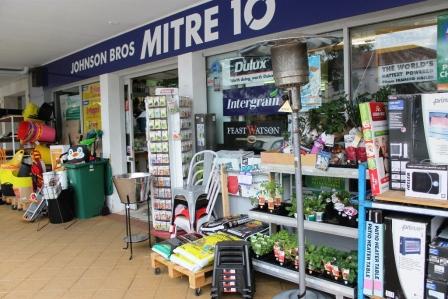 Now that you have created a new garden area by installing your own retaining wall, the question arises – to turn it into lawn, create a Native plant garden, use the height of planting season to grow your own Summer Salad, or create a little niche where your children may have a fairy or dinosaur garden.
Now that you have created a new garden area by installing your own retaining wall, the question arises – to turn it into lawn, create a Native plant garden, use the height of planting season to grow your own Summer Salad, or create a little niche where your children may have a fairy or dinosaur garden.
This week we will take the opportune time of season to plant out a Summer Salad garden – these are alike the Kitchen Gardens of old, crammed with everything that pertains to the season, and can now be planted, only the focus here will be on salad leaves and vegetables.
Growing salad greens from seed means you should be able to harvest these leaves in six weeks' time. Vegetables such as carrots or salad fruits such as tomatoes, take longer to reach harvest time and to these are what you should plant out first. You can also plant out your salad greens now, just be aware that you won’t have a garden with everything you may want in your Summer Salad until December – a good time to have these within arms reach anyway if we experience the usual Christmas prices on fresh produce!
You can buy seeds or seedlings, depending on what will suit you best.
Sow seeds in seed-raising trays or straight into the garden. To sow in trays; fill trays with moist seed-raising mix then lightly press the mix down and sow the seeds thinly. Sieve a fine layer of soil over seeds. Lightly press the soil down and water gently. Leave in a warm spot out of direct sunlight. After germination, when each seedling has grown three small leaves, use a dibbler/stick (a gardening tool for making small holes) to ease out seedlings and plant them, either directly into the garden or in a large tub or trough on your balcony or patio.
 SPEAR AND JACKSON TRADE QUALITY SHOVELS ($39.00 EACH) Trade quality.Oak timber handle. 2mm carbon steel head with hammertone powder coated finish.
SPEAR AND JACKSON TRADE QUALITY SHOVELS ($39.00 EACH) Trade quality.Oak timber handle. 2mm carbon steel head with hammertone powder coated finish.
The main problem you could have is possums eating your new plants as they sprout- the way to get around this is to install some possum proof chicken wore – either in baskets around plants or over the whole garden bed itself – many a Pittwater gardener has given up due to seeing their fresh lettuce and parsley disappear in overnight possums raids – so make sure you leave room for stakes to hold chicken wire to protect your garden!
The layout of your Garden Bed
 Ensuring everything in your Summer Salad Garden gets as much sun or shade as it needs, and creating an attractive design into the bargain, requires looking at what you’re going to place alongside each other, and whether these are plants compatible with each other when growing in one garden bed. Plants that need more sun will need to be on the outside of your bed (Basil) or will grow taller (tomatoes, cucumbers or capsicums on stakes or frames for example) and still require sun could be planted towards the back, sides or the centre of your garden bed. Carrots prefer a cooler soil, so these could be planted in the bed where shade covers the ground for part of the day, r towards its centre as they won’t be getting bigger before the other plants suggested here have grown tall enough to offer some shade, while radishes too are more adaptable and can be used as row markers for your other plants.
Ensuring everything in your Summer Salad Garden gets as much sun or shade as it needs, and creating an attractive design into the bargain, requires looking at what you’re going to place alongside each other, and whether these are plants compatible with each other when growing in one garden bed. Plants that need more sun will need to be on the outside of your bed (Basil) or will grow taller (tomatoes, cucumbers or capsicums on stakes or frames for example) and still require sun could be planted towards the back, sides or the centre of your garden bed. Carrots prefer a cooler soil, so these could be planted in the bed where shade covers the ground for part of the day, r towards its centre as they won’t be getting bigger before the other plants suggested here have grown tall enough to offer some shade, while radishes too are more adaptable and can be used as row markers for your other plants.
Where your Summer Salad Garden is in your yard and the slant of the sun during the next three months needs to be observed too. If the spot you want to place one in only gets an hour of sun just after dawn, it’s probably not going to be enough sunlight. If you choose a spot that gets too much, some plants will thrive and others won’t.
Watering and Feeding and Keeping Pests at Bay
Watering early in the morning before sun can burn magnified leftover water on leaves is recommended. If it has been a dry day, watering an hour to half hour before sunset is best so water will be absorbed or evapourate and not cause rot in roots. Mulching well after planting out will help your soil retain moisture and as the mulch breaks down it will feed viatl nutrients into your soil.
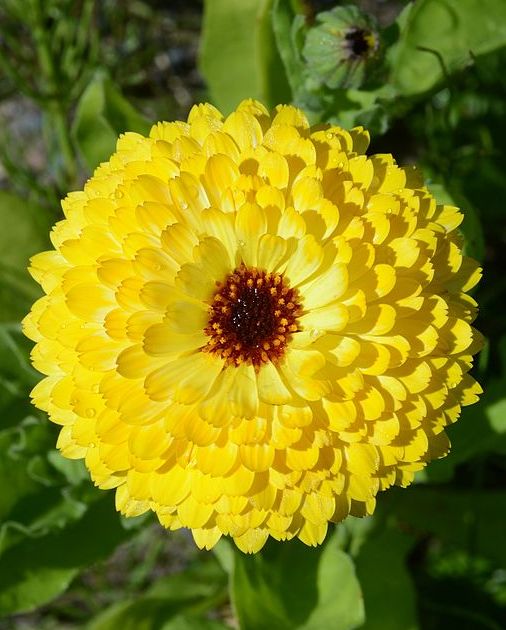 Feeding your vegetable garden, preparing the bed prior to planting and mulching to keep in moisture are all vital aspects of harvesting and harvesting all summer long. Each plant has different needs and we have listed these under each vegetable/leaf suggested. If you’re going to use a dynamic lifter (chook pellets) to boost your soil prior top planting, be aware that many of these need to ‘settle’ for a certain length of time prior to planting as they may burn roots.
Feeding your vegetable garden, preparing the bed prior to planting and mulching to keep in moisture are all vital aspects of harvesting and harvesting all summer long. Each plant has different needs and we have listed these under each vegetable/leaf suggested. If you’re going to use a dynamic lifter (chook pellets) to boost your soil prior top planting, be aware that many of these need to ‘settle’ for a certain length of time prior to planting as they may burn roots.
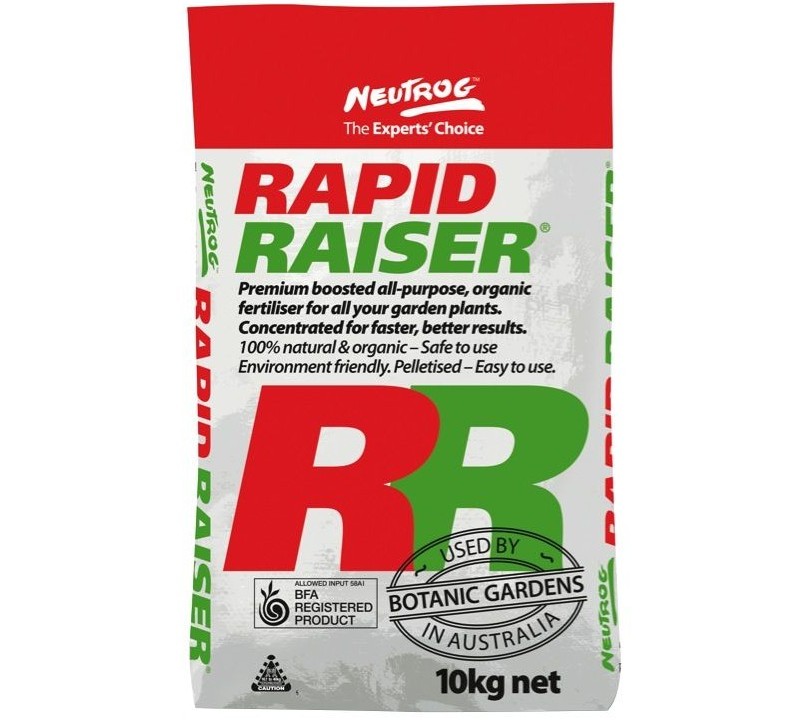 NEUTROG RAPID RAISER 20KG FERTILISER - All purpose organic garden pellets. $16.00
NEUTROG RAPID RAISER 20KG FERTILISER - All purpose organic garden pellets. $16.00
Companion plantings, such as planting Marigolds around the base of tomato plants will keep away the nibblers. A snail beer trap can work wonders and avoids the risk of kill your pets or other furry visitors with commercial snail-baits. Simply bury a container level with the ground and fill it with beer. Snails and slugs find the beer irresistible and drown, possibly while hiccuping!
Summer Salad Garden Glossary
These are only a few suggestions from what we have successfully grown here in Pittwater during the past decades – some plants have done better in small pots, others do better even in hot sunny spots and clay soil. All of those listed can be planted now for a great way to harvest your food from your own garden and provide children with a great insight into where their food comes from – the earth. Many of these suggestions are easy to grow and those liked by children tat can be eaten straight from the Summer Salad Garden patch!
You will also find that salad vegetables and leaves grown at home have a sweeter taste, and since you know they’ve been grown without pesticides, you won’t be swallowing poison with your yummy salad either.
Carrot (Daucus carota ) Sow seed at a depth approximately three times the diameter of the seed. A hardy root vegetable which grows well in deep cool soil. Carrots take about 3 weeks to show themselves and the first leaves look like grass. If broadcast sowing, mix with radish seeds which will germinate quickly and indicate the sown area. In hotter or dry areas, water well before seeding then cover with boards to maintain the moisture and cool soil for more successful germination. Check every week or so. Over fertilised ground will produce split roots. Protect against carrot fly. It is best to put carrots in a different area of the garden each year for four or five years. Harvest in 12-18 weeks.
Capsicum (Capsicum annuum) are warm season crops and really need to be left to mid spring before planting in cooler climates. Although they are technically perennial plants (go dormant in winter and regrow the following season) they are generally less productive in successive years and are best replaced each season with fresh seedlings. There is a wide range of varieties of both chillis and capsicums. Capsicums like a well fed soil, full sun and regular watering and perform best in hotter temperatures. Their requirements are very similar to those of tomatoes, but don't need as much phosphorous as tomatoes. They do however love calcium and as such, you need to treat the planting area accordingly. Harvest in 10-12 weeks.
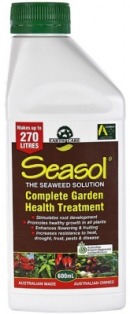 SEASOL 3L WITH BONUS HOZELOCK CONNECTOR Bonus hose connector. $9.00
SEASOL 3L WITH BONUS HOZELOCK CONNECTOR Bonus hose connector. $9.00
Celery: (Apium sp) Grow in seed trays, and plant out in 4-6 weeks. Sow seed at a depth approximately three times the diameter of the seed. Celery needs moist fertile soil. Most varieties improve with blanching but there are some self-blanching varieties available. To Blanch: plant in trenches 15- 20 cm (6-8 in) deep and 20cm (8in) apart. Leave about 40 cm (17 in) between rows. Fill the trenches gradually and keep well watered as the plants grow. The plants can be lifted as needed after about 11 weeks. Alternatively wrap the plants in sleeves of paper or black plastic. Harvest in 17-18 weeks.
Cucumber: (Cucumis satavis) Sow in garden at a depth approximately three times the diameter of the seed. Compatible with (can grow in same bed): Nasturtiums, Beans, Celery, Lettuce, Sweet Corn, Cabbages, Sunflowers, Coriander, Fennel, Dill, Sunflowers. Avoid growing near tomatoes as they will compete for nutrients.Harvest in 8-10 weeks.
Eggplant: (Solanum sp.) Compatible with (can grow in same bed): Beans, capsicum, lettuce. Grow in seed trays, and plant out in 4-6 weeks. Sow seed at a depth approximately three times the diameter of the seed. Eggplants like a lot of sun so if you face them east in a row, and stake them up once the vine grows, they will thrive as well as provide a shade shelter for more tender herbs to thrive behind and then get end of day gentler sun. They thrive in a well fertilised soil and have similar requirements to those of Tomatoes – it is not a good idea to grow these two side by side – at opposite sides of your Summer Salad Garden bed will work best. Harvest in 12-15 weeks.
Herbs: Basil, parsley, chives, dill
Spring Onions: (Allium fistulosum) Easy to grow. Sow in garden. Sow seed at a depth approximately three times the diameter of the seed. Compatible with (can grow in same bed): Lemon Balm, Borage, Carrots, Beets, Silverbeet, Lettuce. Spring onions are grown close together and harvested before fully mature. Do not like to be too dry. Best grown in a sheltered, sunny spot. Harvest in 8-12 weeks.
Tomato: (Lycopersicon esculentum) Grow in seed trays, and plant out in 4-6 weeks. Sow seed at a depth approximately three times the diameter of the seed. Compatible with (can grow in same bed): Asparagus, Chervil,Carrot, Celery, Chives, Parsley, Marigold, Basil. Harvest in 8-17 weeks.
A freshly picked tomato, warm from the sunshine, is one of our favourites. We find that the small cherry tomatoes grow best here and will keep producing fruit. Tomatoes can also be grown in small gardens or even a unit with a window-box; so grow them in pots, troughs or even hanging baskets. The important thing to remember with tomatoes is that they need feeding. In a garden bed, compost and mulching will produce a crop from one or two plants. In containers, use some suitable long term fertiliser pellets or feed regularly when you water. Feeding also improves the flavour of the fruit. When you plant out in a garden bed, put the seedlings in a deep holes, up to the top set of leaves. The covered stems will put out extra roots and you will have a stronger, healthier plant.
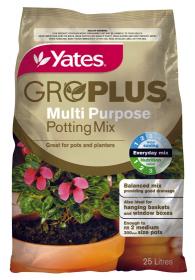 YATES GRO PLUS MULTI PURPOSE POTTING MIX 25L. Ideal for pots and planters. Contains Dynamic Lifter organic fertiliser. $10.00
YATES GRO PLUS MULTI PURPOSE POTTING MIX 25L. Ideal for pots and planters. Contains Dynamic Lifter organic fertiliser. $10.00
Lettuces:
Green coral lettuce (Lactuca sativa) is a loose-leaf lettuce with curly, bright green leaves. It grows well from seedlings.
Cos ruby lettuce (Lactuca sativa) is a large lettuce with long, crisp leaves. Leaves are quite firm with strong mid-ribs. Cos lettuce takes longer to mature than other varieties.
Mignonette lettuce (Lactuca sativa) is a soft-leafed lettuce, high in folates.
Butterhead lettuce (Lactuca sativa) has soft, smooth leaves with a buttery texture and mild flavour. If left to mature it will form a beautiful buttery heart.
Red coral lettuce (Lactuca sativa) is beautifully coloured, frilly and delicious.
Lettuce varieties offer a range of shapes, sizes and colours and all are easy to grow. Choose a variety marked on the seed packet as suitable for the time of year as some do badly in the very hot months. Try to provide some shade to prevent them 'bolting' to flower and seed in the hottest months. They do need a sunny position and regular watering with a liquid feed that is high in nitrogen though, so ensure their placement allows for morning sun. As they grow, pick the outer leaves as you need them; this encourages fresh leaves to grow from the centre. Leaf crops will last up to six months in the garden, meaning you'll be able to enjoy healthy and flavoursome leaves all summer long. Plant them from mid to towards the back of your garden bed so the plants growing taller (your rows of tomatoes, cucumbers and eggplants), can provide them with some shade during hottest parts of the day. Harvest in 8-12 weeks.
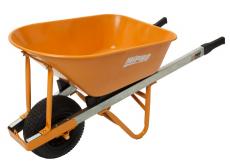 MIPRO® BUILDER'S GALVANISED WHEELBARROW 100L. Steel handles. Extra-wide wheel. 32mm welded steel leg assembly. Ready to assemble. $169.00
MIPRO® BUILDER'S GALVANISED WHEELBARROW 100L. Steel handles. Extra-wide wheel. 32mm welded steel leg assembly. Ready to assemble. $169.00
Radishes: (Raphanus stivas) Compatible with (can grow in same bed): Chervil, cress,lettuce, leeks, spinach, strawberries, tomatoes. Very easy to grow. Good for a child's first garden as seedlings appear in two or three days. Sow between other vegetables as they will mark the rows until the slower germinating plants appear. Harvest in 5-7 weeks.
Johnson Brothers Mitre 10 Spring Specials catalogue is now available and all items on sale until October 19th, some of which are throughout this Summer Salad Garden page.
Next DIY Page: Planting a water-wise Native Plant Garden
This planting guide is a general reference intended for home gardeners. We recommend that you take into account your local conditions in making planting decisions.
.jpg.opt489x691o0,0s489x691.jpg?timestamp=1412743583753)


Products advice is available from the trained friendly staff at Mona Vale and Avalon Johnson Brothers Mitre 10.
Previous DIY Pages:
Decking Timbers Caring For Your Deck Decking Finishes Privacy Screens I Privacy Screens II Privacy Screening Hardwoods Autumn Paths and Lawns Insulation Batts Plasterboard Ventilation - Edmond's Ecofan Blackboards for Children and Home Spring Lawn Care Shade Sails & Watering Basic DIY Tools DIY Tools - Power Drills Recycle Your Trampoline into An Air Bed How to Build Your Own Backyard Cricket Pitch Christmas Lights Displays around House and Garden Summer Mildew - Refresh, Renew How to Fix Things That Drip and Bump in the Night Time To Plant Winter Vegetables – Raised Garden Beds Layout Orgainsing Your Tool Shed Make Your Own Weathervane Installing A Garden Watering System Decking Oils How To Make Garden Compost How To Winter proof Your Lawn How to create Shabby Chic effect on Timber Furniture How to Build Your Own Raised Garden Bed Growing Your Own Winter Vegetables Winter Heating Guide Prepare Your Yard For Winter Eradicating Noxious Weeds From Your Yard How to Fix Furniture Finishes Part I How to Repair Scratches, Dings, and Dents of Furniture Surfaces - Part II Winter Draughts Fix Classic Wooden Tool Carrier Spring Garden Checklist Part I Install Your Own Skylight Retaining Walls for Saving Soil and New Spring Garden Beds
Copyright JBH Mitre 10, 2014. All Rights Reserved .
